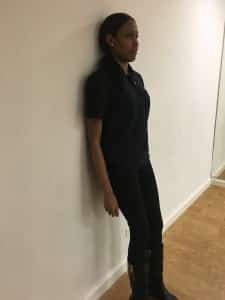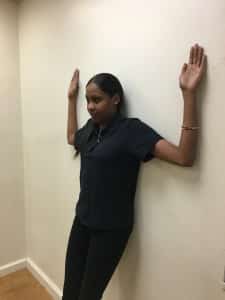Functional Movement Screen Wall Slides
As physical therapists, we often use the same exercises for many patients due to versatility (goal of the intervention), neuromuscular feedback (movement patterning), and appropriateness for the patient's level of function. One of my favorite exercises that fits these requirements are FMS (functional movement screen) Wall Slides. The patient populations I use this for include those with poor posture, limited thoracic spine mobility, and/or poor activation patterns of their scapula (shoulder blade) or shoulder joint muscles. This exercise is also easy to reproduce at home, as all you need to perform it is a wall slightly wider than your body width.
FMS Wall Slides
- To begin this movement, you will have your feet approximately 9-12 inches from the wall, and with a slight bend in both knees, sit back into the wall. Tilt your pelvis into the wall, so that your lower back does not gap away from the wall. Then, tuck your chin so that the crown of your head is also resting on the wall. Contact points: sacrum, entire lumbar spine, mid back, crown of your head.

- Next, with your arms raised to parallel with the floor, press your elbows back into the wall with losing the four contact points. Then bend your elbows to 90 degrees and reach your hands to the wall, without letting your shoulders, elbows, arms, or contact points from step one come off of the wall. Additional Contact points: Shoulders, elbows, hands. For some, this will be challenge enough, so the goal for this individual is to be able to press further and further toward the wall without losing contact at any point. This is a great starting point

- Once you can get into the above position, be cognizant of keeping all points of contact throughout the remainder of the exercise. Slide your shoulder blades away from your ears and towards your hips as you begin to press your hands toward the ceiling. Only go as far as you can without losing contact with the wall. When you get to the point that you feel a deep stretch and/or begin to lose contact, pause for 5 seconds, then slide elbows back toward your side
- Repeat.
This 'simple' exercise provides much challenge to those who need it, and is one that will motivate clients to be able to perform it better, as well as provide information about muscular compensations, deficient flexibility, and/or activation patterning around the shoulder blade and shoulder joint. By prescribing this intervention, physical therapists will notice an increase in anterior chest flexibility, better humeral depression in the joint for overhead reaching, improved thoracic spine flexibility, and improved lower trap/serratus anterior/supraspinatus activation.









